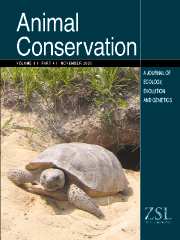Crossref Citations
This article has been cited by the following publications. This list is generated based on data provided by
Crossref.
O'Brien, Timothy G.
Kinnaird, Margaret F.
and
Wibisono, Hariyo T.
2003.
Crouching tigers, hidden prey: Sumatran tiger and prey populations in a tropical forest landscape.
Animal Conservation,
Vol. 6,
Issue. 2,
p.
131.
Trolle, Mogens
and
Kéry, Marc
2005.
Camera-trap study of ocelot and other secretive mammals in the northern Pantanal.
mamm,
Vol. 69,
Issue. 3-4,
p.
409.
GOMPPER, MATTHEW E.
KAYS, ROLAND W.
RAY, JUSTINA C.
LAPOINT, SCOTT D.
BOGAN, DANIEL A.
and
CRYAN, JASON R.
2006.
A Comparison of Noninvasive Techniques to Survey Carnivore Communities in Northeastern North America.
Wildlife Society Bulletin,
Vol. 34,
Issue. 4,
p.
1142.
LINKIE, MATTHEW
CHAPRON, GUILLAUME
MARTYR, DEBORAH J.
HOLDEN, JEREMY
and
LEADER‐WILLIAMS, NIGEL
2006.
Assessing the viability of tiger subpopulations in a fragmented landscape.
Journal of Applied Ecology,
Vol. 43,
Issue. 3,
p.
576.
HEILBRUN, RICHARD D.
SILVY, NOVA J.
PETERSON, MARKUS J.
and
TEWES, MICHAEL E.
2006.
Estimating Bobcat Abundance Using Automatically Triggered Cameras.
Wildlife Society Bulletin,
Vol. 34,
Issue. 1,
p.
69.
Srbek-Araujo, Ana C.
and
Chiarello, Adriano G.
2007.
Armadilhas fotográficas na amostragem de mamíferos: considerações metodológias e comparação de equipamentos.
Revista Brasileira de Zoologia,
Vol. 24,
Issue. 3,
p.
647.
KHOROZYAN, Igor G.
MALKHASYAN, Alexander G.
and
ABRAMOV, Alexei V.
2008.
Presence–absence surveys of prey and their use in predicting leopard (Panthera pardus) densities: a case study from Armenia.
Integrative Zoology,
Vol. 3,
Issue. 4,
p.
322.
Lyra-Jorge, Maria Carolina
Ciocheti, Giordano
and
Pivello, Vânia Regina
2008.
Carnivore mammals in a fragmented landscape in northeast of São Paulo State, Brazil.
Biodiversity and Conservation,
Vol. 17,
Issue. 7,
p.
1573.
Lyra-Jorge, Maria Carolina
Ciocheti, Giordano
Pivello, Vânia Regina
and
Meirelles, Sérgio Tadeu
2008.
Comparing methods for sampling large- and medium-sized mammals: camera traps and track plots.
European Journal of Wildlife Research,
Vol. 54,
Issue. 4,
p.
739.
Rovero, Francesco
and
Marshall, Andrew R.
2009.
Camera trapping photographic rate as an index of density in forest ungulates.
Journal of Applied Ecology,
Vol. 46,
Issue. 5,
p.
1011.
Goulart, Fernando Vilas Boas
Cáceres, Nilton Carlos
Graipel, Maurício Eduardo
Tortato, Marcos Adriano
Ghizoni, Ivo Rohling
and
Oliveira-Santos, Luiz Gustavo Rodrigues
2009.
Habitat selection by large mammals in a southern Brazilian Atlantic Forest.
Mammalian Biology,
Vol. 74,
Issue. 3,
p.
182.
O’Brien, Timothy G.
2011.
Camera Traps in Animal Ecology.
p.
71.
Muhly, Tyler B.
Semeniuk, Christina
Massolo, Alessandro
Hickman, Laura
Musiani, Marco
and
Perc, Matjaz
2011.
Human Activity Helps Prey Win the Predator-Prey Space Race.
PLoS ONE,
Vol. 6,
Issue. 3,
p.
e17050.
Maffei, Leonardo
Noss, Andrew J.
Silver, Scott C.
and
Kelly, Marcella J.
2011.
Camera Traps in Animal Ecology.
p.
119.
Samejima, Hiromitsu
Ong, Robert
Lagan, Peter
and
Kitayama, Kanehiro
2012.
Camera-trapping rates of mammals and birds in a Bornean tropical rainforest under sustainable forest management.
Forest Ecology and Management,
Vol. 270,
Issue. ,
p.
248.
Zimbres, Barbara
Furtado, Mariana M.
Jácomo, Anah T. A.
Silveira, Leandro
Sollmann, Rahel
Tôrres, Natália M.
Machado, Ricardo B.
and
Marinho-Filho, Jader
2013.
The impact of habitat fragmentation on the ecology of xenarthrans (Mammalia) in the Brazilian Cerrado.
Landscape Ecology,
Vol. 28,
Issue. 2,
p.
259.
Srbek-Araujo, Ana Carolina
and
Chiarello, Adriano Garcia
2013.
Influence of camera-trap sampling design on mammal species capture rates and community structures in southeastern Brazil.
Biota Neotropica,
Vol. 13,
Issue. 2,
p.
51.
Torres, Rita Tinoco
Santos, João
and
Fonseca, Carlos
2013.
Persistence of roe (Capreolus capreolus) and red (Cervus elaphus) deer pellet-groups in a Mediterranean mosaic landscape.
Wildlife Biology in Practice,
Vol. 9,
Issue. 3,
Liu, Xuehua
Wu, Pengfeng
Songer, Melissa
Cai, Qiong
He, Xiangbo
Zhu, Yun
and
Shao, Xiaoming
2013.
Monitoring wildlife abundance and diversity with infra-red camera traps in Guanyinshan Nature Reserve of Shaanxi Province, China.
Ecological Indicators,
Vol. 33,
Issue. ,
p.
121.
Goswami, Rajkamal
and
Ganesh, T.
2014.
Carnivore and Herbivore Densities in the Immediate Aftermath of Ethno-Political Conflict: The Case of Manas National Park, India.
Tropical Conservation Science,
Vol. 7,
Issue. 3,
p.
475.


